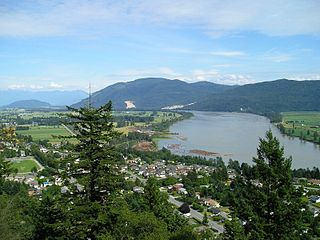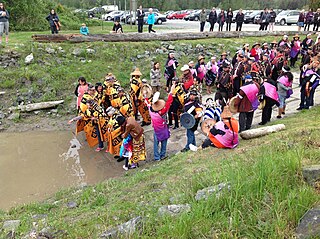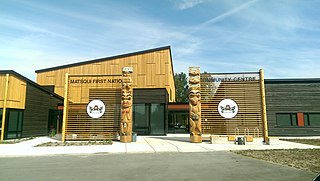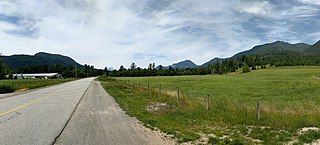Related Research Articles

The Lower Mainland is a geographic and cultural region of the mainland coast of British Columbia that generally comprises the regional districts of Metro Vancouver and the Fraser Valley. Home to approximately 3.05 million people as of the 2021 Canadian census, the Lower Mainland contains sixteen of the province's 30 most populous municipalities and approximately 60% of the province's total population.

The Fraser River is the longest river within British Columbia, Canada, rising at Fraser Pass near Blackrock Mountain in the Rocky Mountains and flowing for 1,375 kilometres (854 mi), into the Strait of Georgia just south of the City of Vancouver. The river's annual discharge at its mouth is 112 cubic kilometres (27 cu mi) or 3,550 cubic metres per second (125,000 cu ft/s), and each year it discharges about 20 million tons of sediment into the ocean.

Abbotsford is a city in British Columbia next to the Canada–United States border, Greater Vancouver and the Fraser River. With a census population of 153,569 people (2021), it is the largest municipality in the province outside metropolitan Vancouver. Abbotsford–Mission has the third-highest proportion of visible minorities among census metropolitan areas in Canada, after the Greater Toronto Area and the Greater Vancouver CMA. It is home to Tradex, the University of the Fraser Valley, and Abbotsford International Airport.

Mission is a city in the Lower Mainland of the province of British Columbia, Canada. It was originally incorporated as a district municipality in 1892, growing to include additional villages and rural areas over the years, adding the original Town of Mission City, long an independent core of the region, in 1969. It is bordered by the city of Abbotsford to the south and the city of Maple Ridge to the west. To the east are the unincorporated areas of Hatzic and Dewdney.

The Fraser Valley Regional District (FVRD) is a regional district in British Columbia, Canada. Its headquarters are in the city of Chilliwack. The FVRD covers an area of 13,361.74 km2 (5,159 sq mi). It was created in 1995 by an amalgamation of the Fraser-Cheam Regional District and Central Fraser Valley Regional District and the portion of the Dewdney-Alouette Regional District from and including the District of Mission eastwards.

The Stó꞉lō, alternately written as Sto꞉lo, Stó:lô, or Stó:lõ, historically as Staulo or Stahlo, and historically known and commonly referred to in ethnographic literature as the Fraser River Indians or Lower Fraser Salish, are a group of First Nations peoples inhabiting the Fraser Valley and lower Fraser Canyon of British Columbia, Canada, part of the loose grouping of Coast Salish nations. Stó꞉lō is the Halqemeylem word for "river", so the Stó꞉lō are the river people. The first documented reference to these people as "the Stó꞉lō" occurs in Catholic Oblate missionary records from the 1880s. Prior to this, references were primarily to individual tribal groups such as Matsqui, Ts’elxweyeqw, or Sumas.

Kwantlen First Nation is a First Nations band government in British Columbia, Canada, located primarily on McMillan Island near Fort Langley. The Kwantlen people traditionally speak hən̓q̓əmin̓əm̓, the Downriver dialect of Halkomelem, one of the Salishan family languages.
The Cheam Indian Band is a First Nations band government of the Stó:lō people in the Upper Fraser Valley region of British Columbia, Canada, located near the community of Rosedale. They traditionally speak the Upriver dialect of Halkomelem, one of the Salishan family of languages. The name Cheam means "wild strawberry place" and is the namesake of Mount Cheam, which overlooks the community and most of the Upper Fraser Valley. They are a member government of the Sto:lo Tribal Council, one of two Sto:lo tribal councils.

Sumas Lake(Halq’eméyle: Semá:th Lake, Nooksack: Semáts Xácho7, ) was a shallow freshwater lake surrounded by extensive wetlands that once existed in eastern Fraser Lowland, located on the south side of the Sumas River between the foothills of Sumas Mountain and Vedder Mountain. It disappeared after being artificially drained for flood control and land reclamation from 1920 to 1924, leaving behind a low-lying flatland known as the Sumas Prairie, which is nowadays drained by the Saar Creek and the namesaked Sumas Drainage Canal.
The Sto꞉lo Nation Chiefs Council is a First Nations Tribal Council in the Fraser Valley region of the Canadian province of British Columbia that is the tribal council for First Nations band governments in the area of Chilliwack, Abbotsford and at Nicomen Island. This tribal council should not be confused with the Stó:lō Tribal Council, which is composed of different bands of the Stó:lō people. Many Sto:lo communities and their governments are not in either tribal council.

The Sumas River is a river in the Fraser Lowland and a tributary of the Fraser River system, coursing across the international border between the Canadian province of British Columbia and the U.S. state of Washington.

The Katzie First Nation or Katzie Nation is the band government of the Katzie people of the Lower Fraser Valley region of British Columbia, Canada.
Matsqui is a former district municipality in British Columbia, Canada. It was incorporated in 1892 and merged with the district municipality of Abbotsford in 1995 to create the new City of Abbotsford. Matsqui used to be the western part of what is now Abbotsford. It had commercial growth in the Clearbrook area which then spilled over to Abbotsford.
The Matsqui First Nation is the band government of the Matsqui people, a Sto:lo Aboriginal group located in the Central Fraser Valley region, at Matsqui, in the northern part of Abbotsford, British Columbia, Canada. They are a member government of the Sto:lo Nation tribal council.
The Soowahlie First Nation, or Soowahlie Band, is a band government of the Sto:lo people located in the Upper Fraser Valley region at Cultus Lake, British Columbia, Canada. They are a member government of the Stó:lō Tribal Council. The Reserve land area currently comprises 533.4 hectares and has a population of 373.
The Leq'á:mel First Nation, formerly known as Lakahahmen First Nation, is a First Nations band government whose community and offices are located in the area near Deroche, British Columbia in the Fraser Valley region in Canada, about 12 kilometres east of the District of Mission. They are a member government of the Sto:lo Nation Chiefs Council, which is one of two tribal councils of the Sto:lo.
Sumas Prairie is a landform in British Columbia, Canada and the State of Washington, United States. Part of the Fraser Lowland, it was created by the draining of Sumas Lake early in the 20th Century, and extends from the Vedder Canal southwestwards into northern Whatcom County, Washington. The British Columbia Highway 1 traverses the former lakebed on the prairie between Abbotsford and Chilliwack.
St. Mary's Indian Residential School was the name of two Indian residential schools in Mission, British Columbia. The first was operated by the Roman Catholic Church of Canada, and the second was operated by the Canadian federal government. Approximately 2,000 children attended the schools while they were in operation, most of them Stó:lō.

The Matsqui people are a Sto:lo Aboriginal group located in the Central Fraser Valley region of British Columbia, Canada. Their band government is the Matsqui First Nation, a member of the Sto:lo Nation tribal council. The core traditional territory of the Matsqui stretches along the Fraser River from Crescent Island to Sumas Mountain, and southward beyond the Canada-United States border. Today the band administers four reserves and has a population of 225. Their original language is Halq'eméylem.

The Hatzic Valley is the southerly, lowland portion of the Fraser Valley Regional District Electoral Area "F" of British Columbia's Lower Mainland. The valley was carved as a result of southward glacial action, being "centered along a low‐lying glacial trough that extends from Stave Lake to the Fraser Valley."
References
- ↑ Sumas First Nation website, Q&A page
- 1 2 3 4 5 6 7 "Sumas First Nation". Prince George, British Columbia, Canada: British Columbia Assembly of First Nations. Retrieved August 22, 2022.
- ↑ Indian and Northern Affairs Canada First Nation Detail
- ↑ "Sumas First Nation chief reflects on 'disaster' B.C. flooding where lake used to be". Global News. Globalnews.ca. Retrieved November 19, 2021.
- ↑ "Leq'a: mel". Prince George, British Columbia, Canada: British Columbia Assembly of First Nations. Retrieved August 18, 2022.
- ↑ Dougherty, Phil (November 5, 2009). "Sumas — Thumbnail History". Seattle, Washington: History Ink/HistoryLink. Retrieved August 21, 2022.
- ↑ "Sumas First Nation | BC Assembly of First Nations". Archived from the original on 2018-02-19. Retrieved 2018-02-19.
- ↑ "Sumas First Nation - Province of British Columbia". .gov.bc.ca. Retrieved February 19, 2022.
- 1 2 3 4 Mills, Kevin (June 26, 2020). "Historic land-transfer agreement in works between District of Mission, First Nations, province". Mission, British Columbia, Canada: Mission City Record. Retrieved August 22, 2022.
- 1 2 Penner, Patrick (July 21, 2021). "Historic agreement signed in Mission transfers 60 hectares of Crown land back to First Nations". Mission, British Columbia, Canada: Mission City Record. Retrieved August 22, 2022.